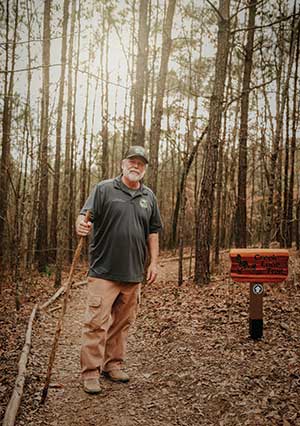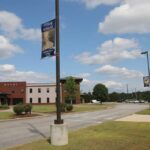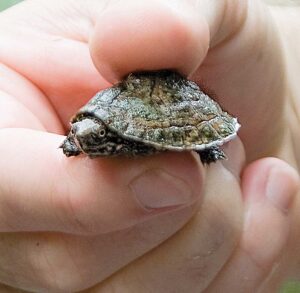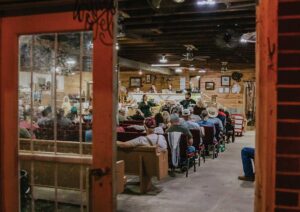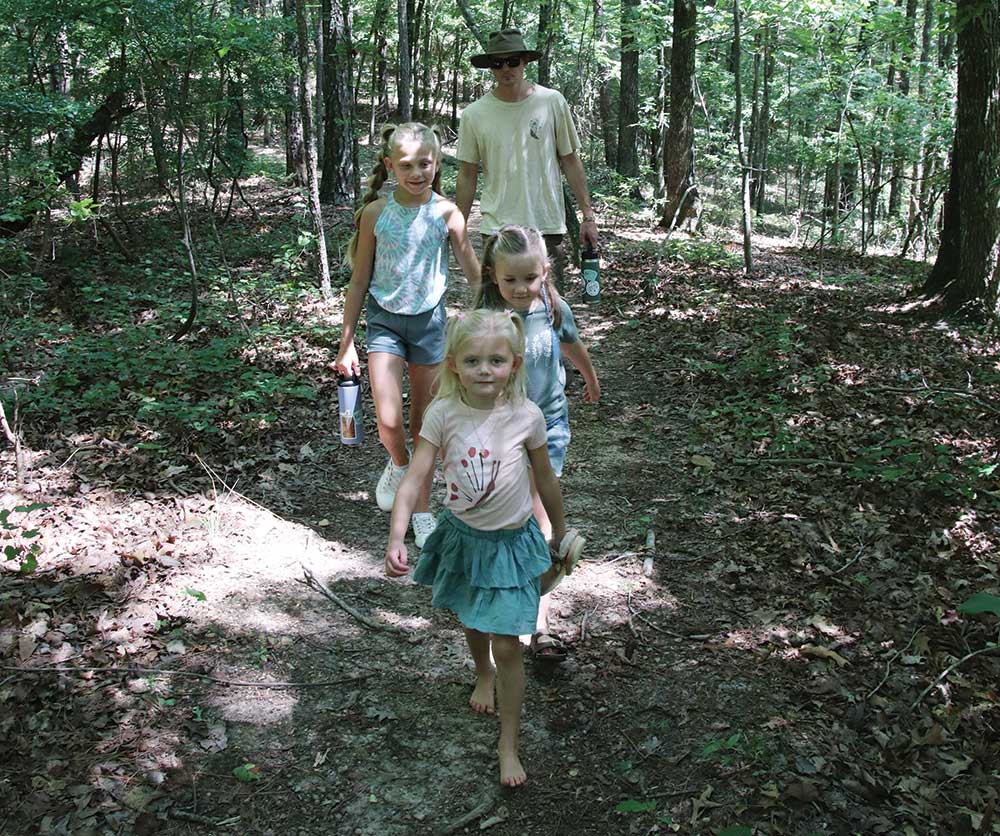
Hiking Big Canoe Creek Preserve
Story by Loyd McIntosh
Staff photos
Located just off of St. Clair County 9 in Springville, Big Canoe Creek Nature Preserve can make you forget you’re just a mile or two away from the highway’s busy intersection of U.S. 11 in the middle of town.
As you drive along the winding, two-lane road covered with trees, you can already feel the temperature drop, even on this hot-as-molten-lava day in mid-August. It’s possible to roll your window down and take in a nice breeze.
The entrance to Big Canoe Creek is just under a half-mile past Homestead Hollow, but, if you’re not paying attention, you can drive right by it without noticing it.
Once you arrive on site, you’re reminded immediately of just how spectacular this part of St. Clair County truly is. On today’s visit, the sky overhead is mostly blue with a few clouds meandering by, and everywhere you look, you see green – undisturbed green. In a word, it’s breathtaking.
The Preserve, which opened to the public in February 2024, began to take shape when Alabama’s Forever Wild Land Trust purchased 382 acres of land in Springville in 2018. A year later the trust added 40 acres, bringing the Preserve to its massive footprint of 422 acres.
Preserve’s Historic Path
The Preserve’s caretaker and longtime advocate is Doug Morrison, now manager of it for the City of Springville. His interest in the area’s preservation goes back to 2007 while serving as the president of the Friends of Big Canoe Creek. Upon learning that the property was being eyed for development, Morrison and other members of Friends of Big Canoe lobbied the Springville City Council to take action to protect the creek.
At minimum, they asked for a riparian buffer, a strip of trees, grass, or shrubs either planted or left intact to protect bodies of water from development. Morrison said they even looked at what other nearby cities were doing to protect other bodies of water.
“A lot of times, developers will just clear every tree, and all of that sediment just goes into the creek,” says Morrison. “We were just trying to get them to be better stewards of the earth and at least leave riparian buffers.
“We even looked at some ordinances that Trussville had, for instance, with the Cahaba River and how they have setbacks leaving riparian buffers, basically just saying ‘leave the natural vegetation that’s already there,’ “ Morrison recalls.
Soon after the developers scrapped their plans altogether in the wake of the 2008 financial crisis, and Morrison and others continued their quest to preserve and protect the creek and surrounding property.
Upon learning about the Forever Wild Land Trust, an initiative created by the state of Alabama in the early 90s, Morrison began approaching landowners about nominating their land for a potential sale to Forever Wild, a goal that took almost a decade of negotiations to accomplish.
With help from Springville and St. Clair County leadership and the owners of Homestead Hollow, the initial 386 acres were sold to Forever Wild in 2018.
Morrison says the creek had been affected by other developments in the area over the years, but it is now well on its way to full recovery. Big Canoe Creek is home to more than 58 species of fish, making it number one in Alabama in aquatic biodiversity. It is number four nationally in total biodiversity, and number one in the nation in aquatic diversity.
Still, Morrison says efforts are needed to protect “the special critters” of Big Canoe Creek. For instance, the creek is home to the Big Canoe Creek Club Shell, a mussel that can only be found in Big Canoe Creek that was listed as endangered in 2022.
“That’s one of the things we’re trying to tout and educate people about is our waterways are important, they’re special. They are home to a lot of different species of animals, and they’re disappearing at an alarming rate,” explains Morrison. “So hopefully with this preserve, we can get an educational program off the ground to help teach people about our great biodiversity.”
Today’s Path(s)
Big Canoe Creek Nature Preserve boasts four trails, Creek Loop Trail, Easy Rider Trail, Fallen Oak Trail and Slab Creek Trail, ranging from 1.2 miles to 2.5 miles in length available for a mixture of uses – hiking, biking and horseback riding.
You can also canoe or kayak with outfitters on the creek offering gear rentals and guided tours along the creek.
This writer, on the day of his visit, hiked for a bit along the Fallen Oak trail and the Easy Rider Trail, and was struck by the preserve’s natural, rustic beauty – if the word “rustic” isn’t redundant when discussing nature. After a few yards of crushed gravel, the trails give way to narrow dirt paths winding along the natural topography of the land under dense tree cover. The trails are suitable for novices and children, however, anyone who is moderately active to the most experienced hikers will enjoy the trails and the chance to see a variety of wildlife, including the occasional deer.
Morrison says this is the ultimate goal of Big Canoe Creek Preserve: to give everyone a chance to experience the natural surroundings and biodiversity of Big Canoe Creek. He added that the organization, a 501c3 nonprofit organization, is exploring grants for the construction of a pavilion where they can hold educational events and field trips for the county’s school children.
“We want classes to go on field trips and along the trails and along the creeks and just experience nature,” Morrison says. He references an influential book by non-fiction author and journalist Richard Louv titled, Last Child In The Woods. In the book, Louv coined the term “nature deficit disorder,” a concept that resonated with Morrison and one he hopes to remedy over time.
Through the Preserve, he says, “We’re hoping we can do away with nature deficit disorder in St. Clair County.” llock repairman.Goforth, Mayor Thomas, Lucy Cleaver, Lee Jeffrey, Mandi Rae Trot, Candice Hill, Blair Goodgame and Morrison; Springville Parks and Rec Board; bands and individual musicians who played on the side stage and vendors.











